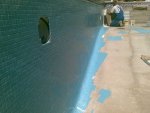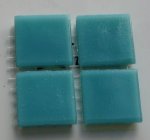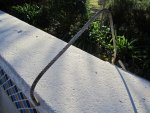solarboy said:I cut them in 2 ways. One is to glue and grout them, then cut them in situ with an angle grinder with a smoooth disk and go slow and gentle. Then chip off the excess. On a rectangular pool we tile from the water line down, and overlap the floor a bit. This is where we cut out a rectangle for the floor. I kind of score it with the disk over and over. Then I use a dremel to just take the nasty sharp edges off. Once grouted you don't notice them. The other way is to cut in the same way but dry on top of wood, but you get a slightly rageddy cut like this but it's quicker. For small areas you can nip them with tile nips. Shocking the price there, Ezarri blue mix here is 25€ sqm (about $35)
you are kidding me, $35???? you should go into the pool tile export business! Here its $30 (cheapest) for 50mm ceramic mosaics from China with Crud glue on the back.




